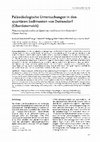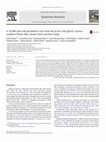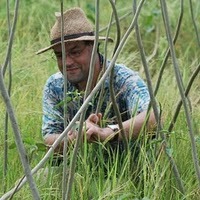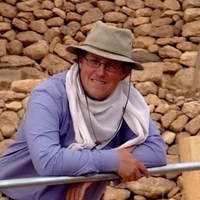Papers by Jean Nicolas Haas

Within the f'ra m ewo rk of corc-drilling through th e p e rmafros t of th e ac tive roc k glac i... more Within the f'ra m ewo rk of corc-drilling through th e p e rmafros t of th e ac tive roc k glac ier. MurteI-Co rvatsch in the Swiss Alps, subfossil stem remains of 'e\'en difTerent bryophy te sp ecies we re found at a depth o f 6 m below surface and about 3 m b elow the perm a frost ta bl e in sampl es from massive ice. Th e compos iti o n o f the moss sp ec ie p oint to the fo rmer growth of the recovered mo ses in the nea rest surroundings of the drill site. A tota l o f 127 pollen a nd sp ores captured by the m osses a nd representing 23 ta xa were determin ed. Th e local vege ta tion during deposition time must be characterized as a m oss-rich alpine g rassla nd mead ow rich in Cyp eraceae, Poaceae, Ch enopodiaceae a nd Asteraceae, compa r abl e to today's fl ora present a ro und the stud y site. For HC a na lys is, acce lerator m ass sp ec trometr y h a d to be used du e to th e sma ll sampl e mass (a bout 0.5 m g Carbon co ntent). Th e mea n co nve ntional llC age of 2250 ± 100 yea rs (I (J va riabilit y) corres ponds to ra nges in th e ca l ibrated ca lenda r age of 470-170 BC a nd 800 BC to AD 0 a t sta tistica l proba biliti es of 68% a nd 95%. respec ti vely. Thi s res ult is co mpared with the present-day now field as determined by high-precisio n photog ramm etr y a nd with inform a tion about th e thickness, \'e rtical structure a nd fl ow of the perm a frost from boreho le meas urements. To ta l age of the rock g lacier as a la nd fo rm is on the order of lO•f yea rs; th e d e\Tlopm ent of th e roc k glac ier m os t probabl y sta rted a round the onse t o f the Holoce ne, w hen th e area it n ow occ upi es beca m e de finit ely deglacia ted. Th e bulk of the ice/rock m ixture within th e cr ee ping perm a fros t mu st be seve ra l th ousand years o ld. Ch arac teri sti c average \'alues a rc es tim ated for (I) surface \'el ociti es through time (cm a \ (2) long-term ice a nd sediment acc reti on rates (mm a I) on the debri s cone from which the rock glacier d evelops, (3) retreat rates (I 2 mm a I) of the cliff which supplies the de bris to th e debris co ne a nd rock glacier, a nd (..J.) ice content of th e creeping ice/rock mi x ture (50-90% by vo lum e). The pro n o unced supersatura ti on of th e p e rm a frost ex pla in s the stead y-sta te cree p mode of the roc k g lac ier.
HAL is a multidisciplinary open access archive for the deposit and dissemination of scientific re... more HAL is a multidisciplinary open access archive for the deposit and dissemination of scientific research documents, whether they are published or not. The documents may come from teaching and research institutions in France or abroad, or from public or private research centers. L'archive ouverte pluridisciplinaire HAL, est destinée au dépôt et à la diffusion de documents scientifiques de niveau recherche, publiés ou non, émanant des établissements d'enseignement et de recherche français ou étrangers, des laboratoires publics ou privés.
Quaternary International
This is a PDF file of an article that has undergone enhancements after acceptance, such as the ad... more This is a PDF file of an article that has undergone enhancements after acceptance, such as the addition of a cover page and metadata, and formatting for readability, but it is not yet the definitive version of record. This version will undergo additional copyediting, typesetting and review before it is published in its final form, but we are providing this version to give early visibility of the article. Please note that, during the production process, errors may be discovered which could affect the content, and all legal disclaimers that apply to the journal pertain.

The Berglibalm rock shelter is located in the municipality of Muotathal in the Bisistal valley at... more The Berglibalm rock shelter is located in the municipality of Muotathal in the Bisistal valley at an altitude of 1140 m a. s. l. The areas excavated in 2015 and 2019 measured 5 m2 and yielded the remains of an Early Mesolithic layer dating from around 8766 to 7596 BC. The charcoal concentrations recorded showed that hazel and maple were the main species used for firewood. The excavation also unearthed many well-preserved faunal remains, a small quantity of plant macrofossils and a lithic assemblage comprising 535 artefacts including 15 microliths. The raw material analysis revealed that the hunter-gatherers preferred local and regional raw materials including fine-grained quartzite (»Ölquarzit«). Some long-distance imports attested to contacts to the Chur and Vorarlberg regions in the east, the Ticino in the south and the Upper Rhine Valley or southern Black Forest region in the north. The rock shelter served as a campsite for Mesolithic hunters targeting ibex, chamois, deer and wil...
Japanese Journal of Palynology
medieval structures in Alpine aera, earthquake, radiocarbon, archaeology, survey

ZUSA.MMEHFA.SSUHC-An den hochglazialen Lößablagerungen von Duttendorf (Österreich) im Gebiet des ... more ZUSA.MMEHFA.SSUHC-An den hochglazialen Lößablagerungen von Duttendorf (Österreich) im Gebiet des pleistozänen Salzachgletschers wurden paläopedologische, sedimentelogische und paläoökologische Untersuchungen durchgeführt, die detaillierte Einblicke in das Paläoklima, das Paläorelief und in die Vegetationsverhältnisse zur Zeit des Sauerstoffisotopenstadiums 2 (OIS 2) erlauben. Es stellte sich heraus, dass alluviale Prozesse eine wesentlich stärkere Rolle bei der Ablagerung des Lößsediments gespielt haben, als dies bisher angenommen wurde. Pollen-und Großrestanalysen belegen die Anwesenheit von feuchteliebenden Pflanzenarten, Mollusken und sogar von Wasserpflanzen, weshalb das Sediment als Schwemmlöß interpretiert werden kann. Die Ergebnisse zeigen, dass die damalige Landschaft im Vorfeld des Salzachgletschers nicht nur einer kalt-trockenen Steppe entsprach, sondern dort auch feuchtere Standorte vorhanden waren, vermutlich lokal sogar Wasserflächen auftraten. Der Fund eines Fichtennadelrestes (Picea abies) könnte zur Klärung der Frage nach der Rolle des Baumwachstums im nördlichen Alpenvorland während des letzten Hochglazials beitragen.

Quaternary Research, 2015
Two cores were drilled on rock glacier Lazaun in the southern Ötztal Alps (N Italy). The average ... more Two cores were drilled on rock glacier Lazaun in the southern Ötztal Alps (N Italy). The average ice content of core Lazaun I is 43 vol.% and of core Lazaun II is 22 vol.%. Radiocarbon dating of plant macrofossil remains of core Lazaun I yielded ages ranging from 8960 cal yr BP at a depth of ca. 23.5 m to 2240 cal yr BP at a depth of 2.8 m, indicating that the ice near the base is approximately 10,300 yr old. The rock glacier was intact since that time and the ice persisted even during warm periods of the Holocene. An ice-free debris layer between 16.8 and 14.7 m separates the rock glacier into two frozen bodies. Inclinometer measurements indicate that both frozen bodies are active and that deformation occurs within a shear horizon at a depth of 20–25 m at the base of the lower frozen body and to a minor extent at a depth of approximately 14 m at the base of the upper frozen body. The ice-free debris layer in the middle of the Lazaun rock glacier indicates a more than five centennia...

The Holocene, 2016
Agro-pastoral activities in the past act as environmental legacy and have shaped the current cult... more Agro-pastoral activities in the past act as environmental legacy and have shaped the current cultural landscape in the European Alps. This study reports about prehistoric fire incidents and their impact on the flora and vegetation near the village of Ardez in the Lower Engadine Valley (Switzerland) since the Late Neolithic Period. Pollen, charcoal particles and non-pollen palynomorphs preserved in the Saglias and Cutüra peat bog stratigraphies were quantified and the results compared with the regional archaeological evidence. Anthropogenic deforestation using fire started around 4850 cal. BP at Saglias and aimed at establishing first cultivated crop fields (e.g. cereals) and small pastoral areas as implied by the positive correlation coefficients between charcoal particles and cultural and pastoral pollen indicators, as well as spores of coprophilous fungi. Pressure on the natural environment by humans and livestock continued until 3650 cal. BP and was followed by reforestation proc...
Rencontres Archéobotaniques, Feb 26, 2018
International audienc











Uploads
Papers by Jean Nicolas Haas
In diesem Posterbeitrag werden die Ergebnisse neuer Untersuchungen zum Einfluss des Klimas auf die alpine Hochlagennutzung am Übergang vom Neolithikum zur frühen Bronzezeit in den zentralen Ostalpen - Graubünden (CH), Tirol, Vorarlberg (beide A) und Vinschgau (I) – anhand archäologischer, paläoökologischer und pedologischer Proxydaten vorgestellt.
Der hochalpine Raum reagiert besonders sensibel auf sich verändernde Umweltbedingungen. Schon geringe klimatische Variationen können das Ökosystem stark beeinflussen. Die Klimabedingungen im Alpenraum ab dem zweiten Jahrtausend v. Chr. sind in etwa mit jenen zwischen Mitte des 19. und Mitte 2o. Jahrhundert n. Chr. vergleichbar (Nicolussi 2oo9, 121). Verschiedene Proxydatensätze deuten für diesen Zeitraum auf eine sich verändernde Niederschlagssaisonalität, hin zu mehr Niederschlag im Sommer (Nicolussi 2oo9, 119).
Aus archäologischer Sicht ist der Übergang vom Neolithikum zur frühen Bronzezeit in den zentralen Ostalpen durch einen massiven Siedlungsausbau gekennzeichnet, der auch peripher gelegene Talschaften miteinbezieht. Diese Landnahme zeichnet sich im archäologischen Fundbild in einer intensivierten Nutzung der alpinen Hochlagen ab, also der Gebiete oberhalb von 2ooo m.ü.M. Bestätigt wird dieses Bild durch neue palynologische und (paläo-)pedologische Untersuchungen aus der Silvretta-Region im Grenzgebiet zwischen Österreich und der Schweiz. Diese legen für diesen Zeitabschnitt verstärkten menschlichen Eingriff im Waldgrenzbereich in Form von Brandrodung nahe, der mit einer Zunahme von Weide- und Kulturzeigerpflanzen einherging.
Die hier präsentierten Forschungen zeigen auf, dass die Intensivierung der Hochlagennutzung in den zentralen Ostalpen zu Beginn der Bronzezeit parallel mit der Aufsiedlung der inneralpinen Talschaften verlief und nach heutigem Erkenntnisstand wohl weitgehend unabhängig von etwaigen klimatischen Stressoren vor sich gegangen sein dürfte.
Literatur
K. Nicolussi, Klimaentwicklung in den Alpen während der letzten 7ooo Jahre. In K. Oeggl/M. Prast (Hrsg.), Die Geschichte des Bergbaus in Tirol und seinen angrenzenden Gebieten. Impulsreferat zum 3. Milestone-Meeting des SFB HiMAT vom 23.-26.1o.2oo8 in Silbertal. Innsbruck University Press, 2oo9, 1o9–24.
The poster will present the results of recent investigations into the impact of the climate on the use of high-altitude Alpine areas during the transition between the Neolithic period and the Early Bronze Age in the central Eastern Alps – Grisons (Switzerland), Tyrol and Vorarlberg (Austria), and Vinschgau Valley (Italy) – using archaeological, palaeoenvironmental and pedological proxy data.
High-alpine areas are particularly sensitive to environmental change. Even the slightest climatic variation can have a significant impact on the ecosystem. From the second 2nd millennium BC onwards, the climatic conditions in the Alps would have been comparable to those from the mid-19th to the mid-2oth centuries AD (Nicolussi 2oo9, 121). Various proxy datasets suggest that seasonal precipitation changed during this particular phase towards increased precipitation in summer (Nicolussi 2oo9, 119).
From an archaeological point of view the transition from the Neolithic to the Early Bronze Age in the central Eastern Alps was characterised by a massive settlement expansion which also included peripheral valleys. In the archaeological record this expansion manifests itself in a more intense use of high-altitude areas, i.e. areas over 2ooo m a.s.l. This is supported by palynological and (palaeo) pedological investigations recently carried out in the Silvretta region in the border area between Austria and Switzerland. They suggest that the period was characterised by increased human impact in the treeline areas as attested to by land-clearances using the slash-and-burn method, along with an increase in pasture and anthropogenic indicator plants.
The research presented here shows that the increased use of high-altitude areas in the central Eastern Alps at the beginning of the Bronze Age occurred at the same time as the settlement expansion in the inner alpine valleys and, according to the current state of research, would largely have taken place independent of any climatic stressors.
References
K. Nicolussi, Klimaentwicklung in den Alpen während der letzten 7ooo Jahre. In K. Oeggl/M. Prast (Hrsg.), Die Geschichte des Bergbaus in Tirol und seinen angrenzenden Gebieten. Impulsreferat zum 3. Milestone-Meeting des SFB HiMAT vom 23.-26.1o.2oo8 in Silbertal. Innsbruck University Press, 2oo9, 1o9–24.